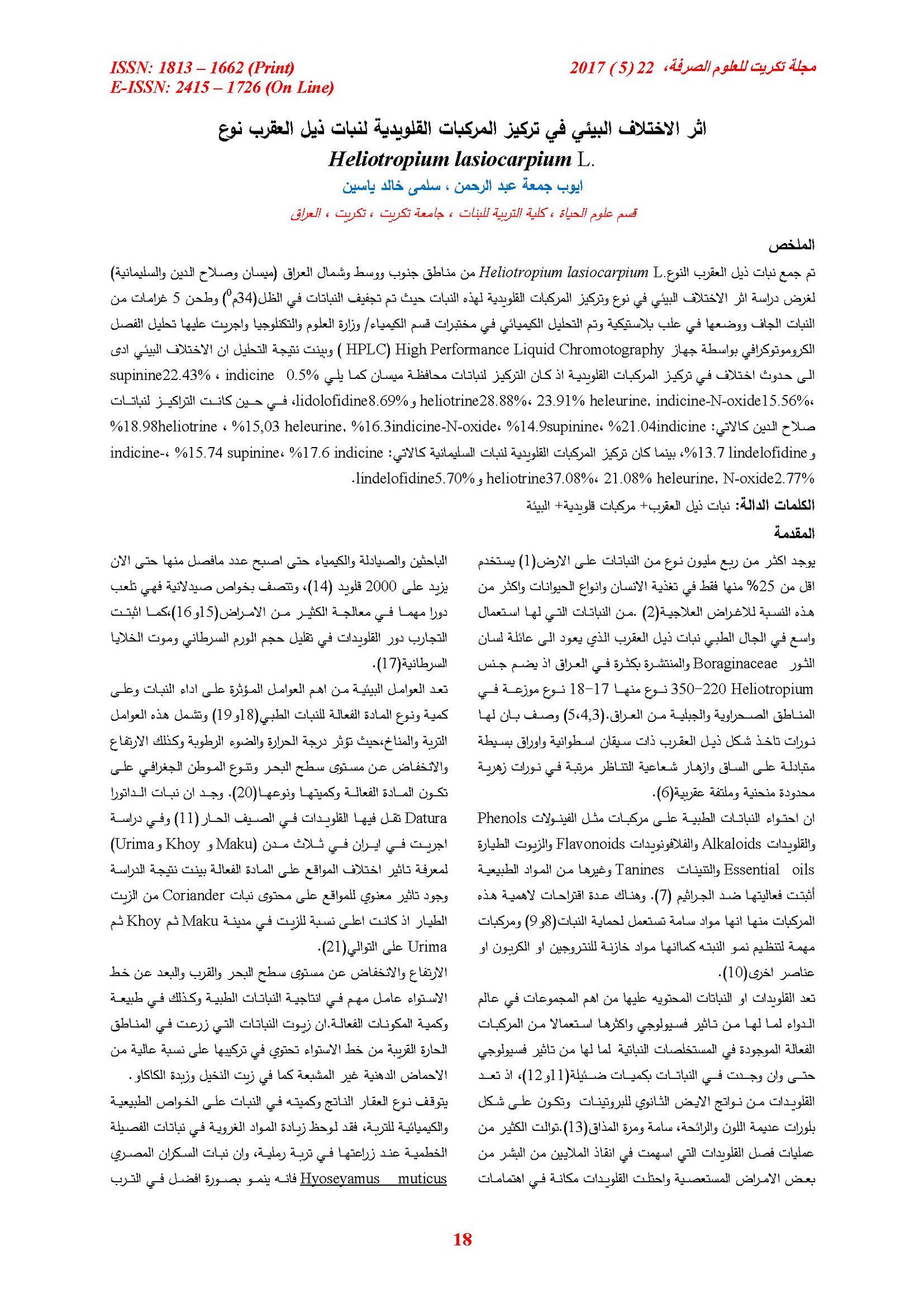Effect of Enviromental varieance on Alkaloids Compounds Concentrate of Heliotropium lasiocarpium L.
Main Article Content
Abstract
Plants of Heliotropium lasiocarpium L. collected from Mesaan, Salahdeen and Sulaimania governorates in order to study the effect of enviromental variance on alkaloids compounds concentration. The plants dried on the shade then 5 gm of the sample put in the plastic content. The chemical analysis conducted in the laboratories of Ministry of science and Technology by HPLC apparatus. Results showed that enviromental varieance lead to varieance in the alkaloids concentrate. In mesaan location the concentration were:indicine 0.5%, supinine 22.43%, indicine-N-oxide15.56%, heleurine 23.91%, heliotrine 28.88% and lindelofidine8.69% while on location of salahdeen were: indicine 21.04%, supinine14.9%, indicine-N-oxide16.3%, heleurine15.03%, heliuotrine18.98% andlindelofidine13.7% and the results on sulaimania location were: indicine 17.6%, supinine15.74%, indicine-N-oxide 2.77%. hleurine 21.08%, heliotrine37.08 and lidelofidine5.70%.
Article Details

This work is licensed under a Creative Commons Attribution 4.0 International License.
Tikrit Journal of Pure Science is licensed under the Creative Commons Attribution 4.0 International License, which allows users to copy, create extracts, abstracts, and new works from the article, alter and revise the article, and make commercial use of the article (including reuse and/or resale of the article by commercial entities), provided the user gives appropriate credit (with a link to the formal publication through the relevant DOI), provides a link to the license, indicates if changes were made, and the licensor is not represented as endorsing the use made of the work. The authors hold the copyright for their published work on the Tikrit J. Pure Sci. website, while Tikrit J. Pure Sci. is responsible for appreciate citation of their work, which is released under CC-BY-4.0, enabling the unrestricted use, distribution, and reproduction of an article in any medium, provided that the original work is properly cited.
References
1-Borris, R.P.(1996). Natural products research: perspectives from amajor pharmaceutical company. J. Ethanopharmacol 51:29-38..
2-Moerman, D.E. (1996). Analysis of the food plants and drug plants of native north Amwrica. J. Ethanopharmacol. 52:1-22.
5- Al-Rawi, A. and Chakravarty, H.L. (1976). Medicinal plants of Iraq. Tech. Bull. 15.Government. press. Baghdad: 276-277.
7- Mollafilabi, A., Hassan, Z.K., Rad, Aroies, R., Sadrabadi, H.S. (2010). Effect of optimizing nitrogen and potassium application injohnson nutrient solution on essential oil content of peppermint in hydroponies culture ActaHorticulturae853,157-160.
8- Wasisht, K (2004), Regiona, Workshoe on Qnaaisty control of medicinal plants products in South Weast Asia ICS-UNISCO.
9- Raja, S., Sajwan, M. and Bisht, N.S. (2009). physiological effect of plant growth characteristics and productive poentioal of verpascum thapsus amedicnal plant, Universitof Garhwa Campas pauri India 1(5):47-51.
12- Mukherjee, A.B.; Sourar, N.S. and Anlic, C. (2001). Advance in Cancer therapy with plan based natural product .Curent medicinal chem.1467-1486.
13- Harbon, J.B. (1981) phytochemical methods Agnid to modern technigues of plant an alysis . 2nd . Ed . London, new york, Chapman and hall .
15- Nithya, T.G,: Jayanthi, J.: Ragunathan, m.g. (2016). Antioxidant activity, total Phenol, flavonoid, Alkaloid, Tanin and Suponin contents of leaf extracts of Salivinia molesta, Asian J. pharmacetical and clinical research 9(1):200-203.
16-Savoia, D. (2012). plant derived antimicrobial compounds: alternatives to antibiotics. futures Microbiol., 7:979-990.
18-Golan, f/; Zaidi, L.: Nezhadohamdi, A. (2014). Genetic analysis of F1 Hybrids derived from
aromatic (Exotic) X aromatic (Malysian) rice crosses and their callus induction performance for haploid production. Indian J.of science and Technology 7 (11): 52-60.
19- Shams, M.: Zandi, E. and Ramezani, M. (2014). Allelopathic effects of weeds on seed germination of Trachyspermum copticum L. J. Bio. and ENvo. sci. 5 (1): 82-90.
21-Mustafskamal, Sh.: Mahdi, R. Sasan, Z. (2016). Effect of climatic factors on the quantity of Essential oil and dry matter yield of Coriander (Coriandrum sativun L.) Indian J. of Science and Technology. 9 (6):1-4.
23-El-Hilali, E.A.: AIT-Oubahau, A. Remah and Akhyat. (2003) Chiling injury and peroxidase activity changes in (Fortune) Mndarin fruit during low temperature storage, Buig. J Plant Physiol.29(1-4):44-54.
24-Cramer, G.r,; Lauchi, A.; Epstein, E. (2006). Effects of NaCl2 on ion activities in complex nutrient solution and root growth of cotton. plant physiol. (81): 792-797.
25- Banon, S.J.: Ochoa, J.A. and Fravco, J.J. (2006). Hardening of leander seedling by diffcit irrigation and low aire humidity ,Enviromental and experimental botany. 1(56):36-43.
26- Storey, R.; Wyn, J.R.G. (1977). Quaternary ammonium compounds in plants relation to salt resistance. Phytochemistry,16:447-453.
27-Stpreu, R.G. (2001). Quaternary ammonium compounds in plants relation to salt. University college of North Wales.
28-Nishizawa, H; Okimura, S. and Abe, Y. (1991). Application liquid partical extraction to the purification of glycryrrhizin. Chemecal pharm. Bull.39:969-971.
